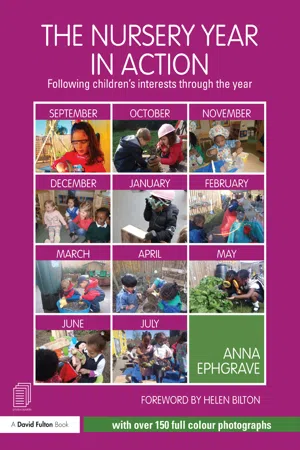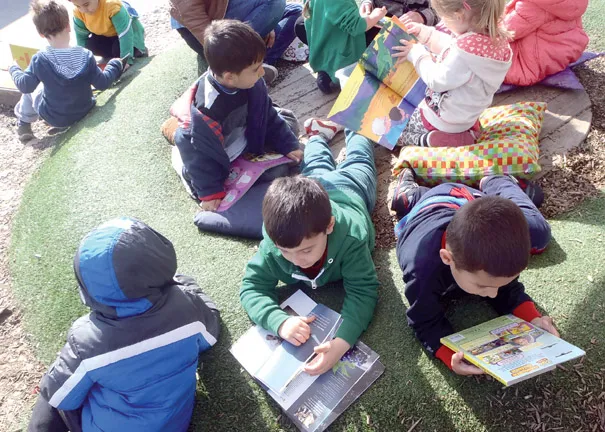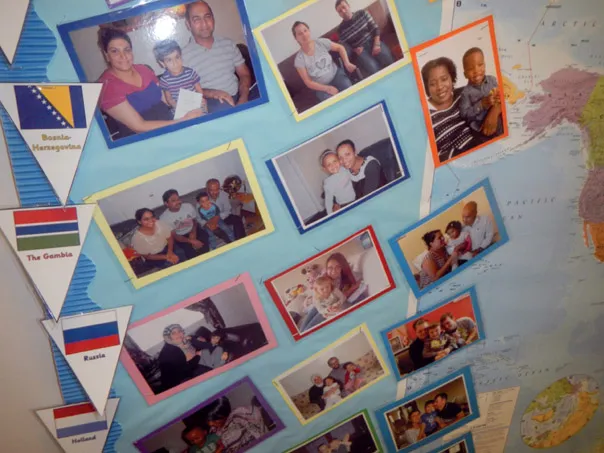![]()
September
SEPTEMBER:TO DO LIST
● Attend staff training.
● Home visit all the children.
● Alert agencies of any concerns after home visits.
● Prepare the class environment – indoors and outside.
● Prepare a coat peg, self-register and an individual folder for each child.
● Organise groups of children to start nursery.
● Welcome and support children and their families.
● Focus on PSE to ensure children are happy and expectations of behaviour are clear.
● Start initial assessments.
Since September is such a special month, this chapter is organised differently from the remaining chapters in the book. The ‘To Do List’ above gives just a hint as to the vast amount of work that is done in this month. I will describe how the month is organised, explain home visits and explore the general principals of how the physical environment is organised. I will go on to explain how the children are introduced to the nursery and the role of the staff at this critical time. There is a short ‘Diary’ section, in which you can see how the induction work continues and the children begin to explore and learn in their new environment. Although we start initial assessments of the children in September, the bulk of this work is done in October and will be described in that chapter.
For many settings, September is a unique month and this is certainly the case for school-based nurseries. The academic year starts in September and therefore this is the month when a huge number of transitions occur – from home to pre-school, from pre-school to nursery, from nursery to reception. All over the country, children are moving to new settings. In many nursery settings the new children join children who are already established in the environment. For others, all the children are new to the setting. It is crucial that their induction ensures a smooth transition into the nursery class. This requires meticulous planning and preparation. Much of this work was started in the summer term and will be described in later chapters of this book. Here I will set out the work we do in September and how the children are inducted into the nursery.
September timetable
The usual timetable for the month of September in school is presented in Figure 1.1.
| Week 1 | 2 days preparing class and garden |
| 3 days home visits |
| Week 2 | 5 days home visits |
| Week 3 | 2 days home visits |
| First groups start nursery (attending for two sessions per week) |
| Week 4 | Remaining groups start nursery |
| Initial assessments completed for some children |
Figure 1.1 September timetable
Thus, by the end of September, all the children have been visited at home, the nursery environment is prepared and all the children are attending nursery for at least two sessions per week. Some initial assessments will also have been completed.
Home visits
In the supermarket last week I met a boy who is now inYear 4. He smiled and said ‘Hello Anna. I remember when you came to my house!’. Six years on and that visit was still a vivid and positive memory for that child! It is easy to forget what a huge, life-changing experience it is for a three year old to step into nursery on that first day. The home visit is one way to ease that step by making the staff members familiar to the child and introducing them in the environment where the child is most at ease – their home. Even if the child is shy and quiet during the visit, they will be watching and listening and they will remember your faces when they arrive at nursery for their first session. Some settings carry out home visits in July and I do worry that the gap between the visit and their first day at nursery may be too long for such young children.
We usually manage six visits per day – depending on distances to be travelled – and the teacher attends with another member of the nursery team. The visit usually lasts about 40 minutes, with one adult talking to a parent, making links with the family and filling in necessary paperwork and the other adult playing with the child. We have made an information booklet for the families and this helps to structure the conversation with the parent and to ensure that we pass on all information necessary. The booklet is left with the family so they can refer back for information as they need it. The booklet covers the curriculum, how the nursery is run, staffing, term dates, clothing, contact numbers etc. It has lots of colour photos to make it attractive to the children and also to help with comprehension for parents who have little English.
In terms of information we gain from the family, we have a form to fill in (see Figure 1.2). However, if at all possible we hope that a frank and open conversation develops and the family can relax. In this way, we gain truly valuable information about the child and family and begin to develop a partnership. We try to get a family photo during the home visit so this can be on display when the children start nursery. This again helps them feel welcome.
Home visit checklist
● Contact form (includes medical information) _______
● Form detailing who can collect the child ______
● Ethnicity form (ensure completed) _____
● Local trip permission letter _____
● Booklet explained & copy left with family _____
● Start date and sessions explained _____
● Photo of child _____
● Photo of family _____
Figure 1.2 Home visit checklist
For the benefit of the child, we take along toys, books, paper, pencils and scissors as well as photos of the school and nursery. If the child is relaxed and confident, this can become a perfect opportunity to assess the child’s personality, interests and abilities. This information can be vital to ensure that the nursery will meet their needs. For example, this year Arda was fascinated by the scissors and spent the whole visit cutting up any piece of paper he was given. He had never used scissors before but clearly loved the experience. Once he started nursery he did not settle easily, but the scissors were the one thing that enticed him to engage and stay willingly at the nursery. Other children often joined him in this activity and therefore several children developed their scissor skills!
One important aspect of the home visit is to inform the family about a start date and how the induction process works. Once we have met the children we are able to put them into groups for various start dates. We usually opt to start the shy or young children first so that they experience the nursery when it is quiet and not too crowded. After the visits we are in a position to decide if we feel any child will need individual support and in extreme cases we can delay the start date until this is in place. Last year, for example, when we arrived for one visit, it was clear that the child would need specialist provision. During the visit it also became clear that the parents thought we were from a special school. Once the situation was clarified, we were able to advise the parents and avoid unnecessary confusion for the child.
We give the children in nursery the opt...





